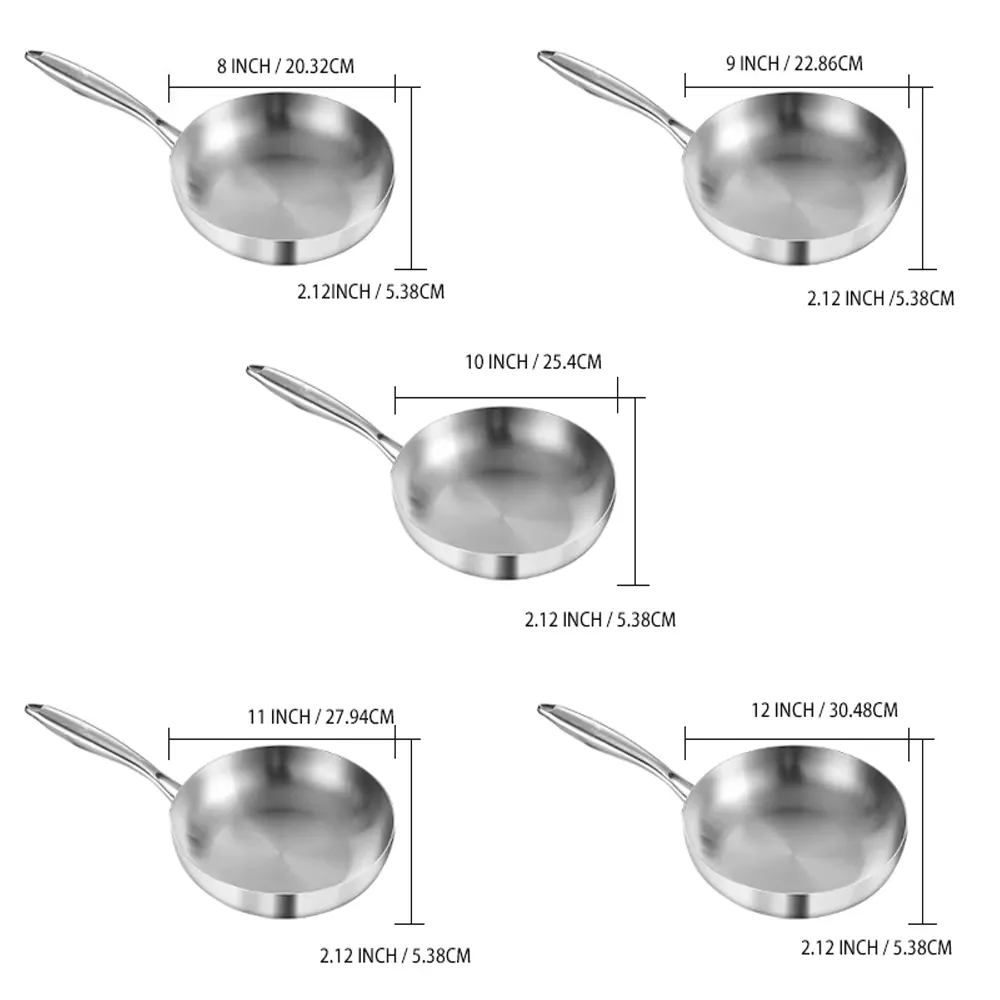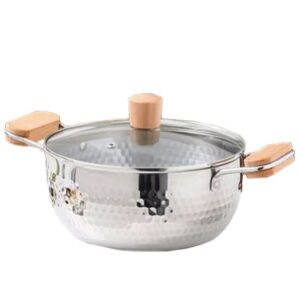عند الشراء أواني الطهي، لا يكفي تحديد المنتج الذي يرغب فيه المرء، بل يجب أيضًا فهم أحجام المقلاة المناسبة اللازمة للطهي اليومي، خاصةً بالنسبة لأداة يومية مثل المقلاة.
نظرًا لوجود العديد من الأحجام المختلفة لأواني القلي للاختيار من بينها، فإن اختيار الحجم الأفضل عند شراء مقلاة قد يكون أمرًا شاقًا، كما أن الاختلافات بين هذه الأحجام أقل وضوحًا مقارنة بأواني الطهي في مجموعات تعتمد على الحجم مثل أواني الطهي مثل الكراكبوت.
جدول المحتويات
تبديلمعنى مصطلح مقاسات المقلاة
أولاً وقبل كل شيء مقلاة هو الحجم من أعلى حائط المقلاة إلى أعلى الحائطأي القطر الأقصى، وليس بقطر سطح الطهي (من الحافة السفلية إلى الحافة السفلية). في الاستخدام اليومي، في حين أنه من الصحيح أن المقالي مقاس 10 بوصة و12 بوصة يمكنها القيام بالعديد من المهام نفسها، إلا أنه لا تزال هناك مزايا للأحجام الأصغر والأكبر - وهو سبب كبير يجعلنا نوصي بوجود مقلاة واحدة صغيرة ومتوسطة وكبيرة على الأقل تحت تصرفك.
نظرًا لاختلافات التصميم في ارتفاع الجدار، عادةً ما يكون هناك مقالي مقاس 12 بوصة لها أحجام سطح طهي مختلفة. على سبيل المثال، المقلاة المصنوعة من الفولاذ المقاوم للصدأ مقاس 12 بوصة لها سطح طهي يبلغ 9.5 بوصة تقريبًا، بينما المقلاة الأخرى المصنوعة من الفولاذ المقاوم للصدأ لها سطح طهي يبلغ 9 بوصات تقريبًا.
5 خصائص أحجام مختلفة من أحجام المقالي المختلفة
مقلاة 6 بوصة
الفائدة: مساحة سطح الطهي المدمجة في هذه المقلاة تعني أن المكونات ستحصل على الكثير من الاهتمام من الحرارة الموزعة بالتساوي على قاع المقلاة وجوانبها.
السيناريوهات: أطباق ذات حصة واحدة مثل الأطفال الهولنديين (المافن) أو العجة أو الفطائر؛ بيضة مقلية أو صدر دجاج؛ توابل أو مكسرات محمصة؛ صلصة الثوم أو زبدة الثوم أو الزبدة البنية أو غيرها من الصلصات للأطباق الجانبية؛ تشويح عدد قليل من الخضروات مثل الفطر.
الحجم المرجعي: القطر الكلي: 6.8 بوصة، قطر سطح الطهي: 4.7 بوصة، الطول: 13.8 بوصة، العمق: 1.25 بوصة، الوزن: 1.25 رطل
مقلاة 8 بوصة

الفوائد: المقلاة الأصغر حجمًا تعني توزيعًا أكثر تكافؤًا للحرارة والقدرة على الوصول إلى درجات حرارة عالية بسبب التعرض العرضي للحرارة من الجوانب المائلة للمقلاة.
السيناريوهات: الوجبات الفردية مثل البيض المقلي أو شرائح اللحم أو صدور الدجاج، وإعداد العجة السميكة والسميكة (يتم إجبار البيض على الصعود إلى أعلى بسبب صغر سطح الطهي)، وتشويح الخضار كطبق جانبي.
الحجم المرجعي: القطر الكلي: 8.5 بوصة، قطر سطح الطهي: 5 بوصة، الارتفاع: 2.75 بوصة، الطول: 15.2 بوصة، العمق: 1.75 بوصة، الوزن: 1.75 رطل.
مقلاة 10 بوصة
الفائدة: المقلاة متوسطة الحجم تعني أرضية وسطية حيث يمكن وضع المزيد من الأشياء في المقلاة دون اكتظاظها. مع الحد الأدنى من التضحية في الاحتفاظ بالحرارة.
السيناريوهات من 2 إلى 3 حصص (أي قلي 3 بيضات أو 2 صدر دجاج) وقلي 3 بيضات أو 2 صدر دجاج، وإعادة تسخين بقايا الطعام، وقلي الكثير من الخضراوات.
الأبعاد: القطر الكلي: 10.5 بوصة، قطر سطح الطهي: 7.5 بوصة، الارتفاع: 3.5 بوصة، الطول: 18.5 بوصة، العمق: 1.75 بوصة، الوزن: 2.25 رطل.
مقلاة 12 بوصة
الفائدة: المقلاة الكبيرة تعني أنه يمكنك طهي كمية كبيرة من الطعام في المقلاة في وقت واحد دون اكتظاظ المقلاة. كما أنها تعني أيضاً احتفاظاً أكبر بالحرارة، حيث أن هناك المزيد من المواد التي تحافظ على الحرارة.
سيناريوهات: قلي 4 بيضات أو 3 صدور دجاج، أو قلي شرائح اللحم المقدد دون الحاجة إلى تقليم الأطراف، أو صنع البيتزا المسطحة أو الجاليت أو الأطفال الهولنديين (12 بوصة هو الحجم المثالي لمقلاة الفرن الآمنة).
الحجم المرجعي: القطر الكلي: 12.5 بوصة، قطر سطح الطهي: 9.5 بوصة، الارتفاع: 3.5 بوصة، الطول: 20.5 بوصة، العمق: 1.75 بوصة، الوزن: 3 أرطال
كيف تختار حجم المقلاة المناسب؟
يجب أن يكون منع الاكتظاظ على رأس الأولويات، حيث أن المكونات المكتظة تسخن بشكل غير متساوٍ وتنضج بشكل غير متناسق، مما يؤدي بدوره إلى إطالة وقت الطهي ويضر بالنكهة المثلى.
- مطبخ صغير أو مطبخ صغير لشخص واحد: إذا كان لديك مطبخ صغير، أو يمكنك الطهي لشخص أو شخصين فقط في المرة الواحدة، أو يمكنك الطهي بشكل غير منتظم، فربما يمكنك الاكتفاء بقدر صغير إلى متوسط الحجم (8 بوصة أو 10 بوصة).
- مطبخ أو طهي متعدد الأشخاص:: إذا كنت تجمع أواني الطهي وتطبخ في أوقات أكثر ولديك عدة أفواه لإطعامها كل ليلة، فإن المقلاة ذات الحجم الأكبر (12 بوصة أو 14 بوصة) مثالية وفعالة.
في الختام، يجب أن يعتمد اختيار المقلاة على عادات الطهي اليومية وحجم عائلتك. لكل مقلاة حجم مزاياها الفريدة، وفهم استخدامات الأحجام المختلفة يمكن أن يساعدك على الاختيار الأفضل.







